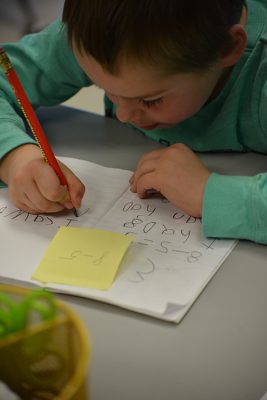Using Writing to Engage Your Students in Math: Key Recommendations from the NSF-Funded Elementary Mathematics Task Force
While educators have long been encouraged to engage students in writing when teaching math, specific recommendations on how to leverage writing to enhance learning of mathematics have fallen short — until now.
Due to an overall lack of research in the discipline of mathematical writing and the need to improve mathematics understanding among schoolchildren, educators from across Connecticut and the U.S. gathered this past year as a task force to research and determine best practices regarding how elementary-age students can utilize writing to increase their comprehension of mathematics through reasoning.
The 25-member Elementary Mathematical Writing Task Force — funded by the National Science Foundation (NSF) and co-led by faculty members from the Neag School and Saint Joseph’s University in Philadelphia — was charged with outlining the types of, and purposes for, mathematical writing at the elementary-grade levels. The task force’s full recommendation report is available online as a free resource for educators.
“For a quarter of a century, the mathematics education field has emphasized communication as a crucial component in learning mathematics,” according to the task force’s project description. “However, until now, descriptions of the types of and purposes for mathematical writing have fallen short in adequately informing instructional practices.”
4 Types of Mathematical Writing
The task force included experts across various disciplines — including practitioners and academics from the fields of mathematics education, mathematics, and writing education — in order to guide the project. The group also drew from some members’ experience developing assessments and authoring curriculum resources that attend to mathematical writing.
“It was very important for us to draw from diverse perspectives to ensure we comprehensively addressed mathematical writing and also that, in the end, the recommendations would be applicable in actual classrooms for various student groups,” says Tutita Casa, co-principal investigator on the project and an assistant professor at the Neag School.
The Elementary Mathematical Writing Task Force set out to create a set of recommendations that would have a significant and positive impact on teachers, researchers, curriculum developers, and assessment writers — while ultimately benefiting elementary students. These efforts are beginning to open up a comprehensive line of inquiry in the area of mathematical writing at a critical juncture in the history of mathematics education.
The task force’s report outlines four types of mathematical writing with overarching goals to have students engage in mathematical reasoning and communication:
- Exploratory
- Informative/explanatory
- Argumentative, and
- Mathematically creative
The purposes for engaging students in each type of mathematical writing is defined as well. The task force has also reached out regarding conference submittals and papers for possible publication. They have been accepted to present at three conferences thus far, including the National Association for Gifted Children (NAGC) Annual Conference at Walt Disney World, Fla., the Association of Mathematics Teacher Educators (AMTE) Annual Conference in Orlando, Fla., and the National Council of Supervisors of Mathematics (NCSM) Annual Conference in San Antonio, Texas.
How the Project Came About
“The seed for this project was planted years ago when I worked on two federally funded projects that produced and researched the efficacy of advanced mathematics curriculum units,” says Casa. One of those projects, Project M3: Mentoring Mathematical Minds, involved Casa in working “very closely with grades 3-5 teachers and follow[ing] classes of mathematically promising students across three years.” She had also led efforts to help grades K-2 students write mathematically in Project M2: Mentoring Young Mathematicians.
While writing was a feature of those projects, Casa says there was limited literature available at the time describing exactly what students should be writing about in math class. “It became clear to me that the mathematics education field would greatly benefit from more clearly defined types of writing taking place during mathematics instruction and the purposes that could further students’ learning of the content,” she says.
“In terms of teaching, we can now start thinking about how these types of writing could fit within specific math lessons. Many math teachers are not well-versed in how to support writing, or even that they should.” Jack Dieckmann, associate director of curriculum at Stanford University’s Stanford Center for Assessment, Learning, and Equity
The Importance of the Recommendations
As a result of the newly issued recommendations, teachers and researchers now can approach their work in much more informed ways, according to members of the task force. Writing has the potential to further individual students’ learning of any content, and having clarity on the type of and purposes for mathematical writing specifically allows educators to maximize their efforts in this particular subject area.
“The recommendations that resulted from the task force may serve to focus discussions about the types of and purposes for mathematical writing that may be most beneficial in enhancing elementary students’ mathematical understanding,” says Janine M. Firmender, co-principal investigator on the project and assistant professor at Saint Joseph’s University.
Prior to the creation of the task force, research in mathematical writing was limited. Even today, according to Casa, any recommendations on mathematical writing similar to those issued by the Elementary Mathematical Task Force do not yet appear to exist.
“There is nothing in mathematics education literature of which we were aware of, which was the impetus for this project,” she says. “There are very few mathematics educators who have comprehensively done work in this area, and, thus, we did not have explicit expectations for the task force’s outcomes. We did hope that the recommendations were going to bring much needed clarity, and are thrilled that this was the case.”
According to task force member Jack Dieckmann, associate director of curriculum at Stanford University’s Stanford Center for Assessment, Learning, and Equity (SCALE), the “recommendations are important because they provide a sort of taxonomy for the different kinds of writing in math that we value.”
“Now that we have this list, we can start examining curricula to see how these types of writing are supported, or could be supported,” he says. “Also, in terms of teaching, we can now start thinking about how these types of writing could fit within specific math lessons. Many math teachers are not well-versed in how to support writing, or even that they should.”
How Can the Recommendations Be Used?
“Teachers first can realize the potential influence that writing can have on students’ learning of mathematics,” says Casa. “They can maximize the time they already take to have their students write in math class or begin to implement mathematical writing informatively.”
The recommendations provide various purposes for mathematical writing, which should drive the types of writing that students can do. Teachers will now have another tool to further students’ mathematical reasoning in addition to, for example, oral discourse and manipulatives.
Educators may utilize the task force’s recommendations in a variety of other ways as well, says Firmender. “For example, the recommendations may serve as a lens through which professional development can be offered or how teachers may view mathematical writing tasks and student writing.”
“I think the best use for now would be for teachers to read and reflect to see if they understand these types of writing,” says Dieckmann. “Some professional development or more student examples might be needed. But then teachers can start to see where they can incorporate them into their teaching.”
The expectation is that students will also benefit directly. “Students now can have an additional medium from which to make sense of mathematics and further their reasoning,” says Casa. “Mathematicians write all of the time, and having students learn that this is a key component of the discipline can allow them to have a more authentic vision of the discipline.”
Learn more about the Elementary Mathematical Task Force — and access the final recommendations for free — at mathwriting.education.uconn.edu.



